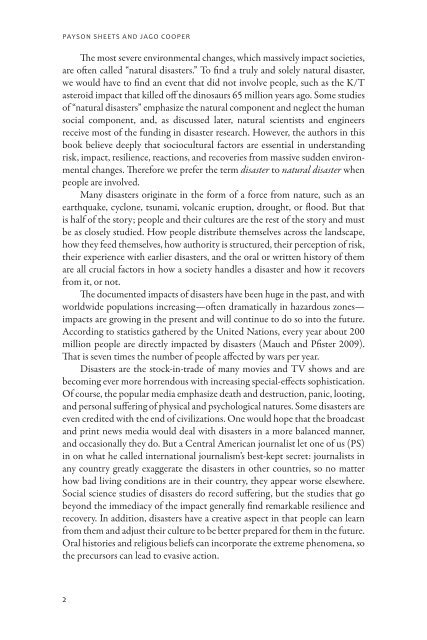free download - University Press of Colorado
free download - University Press of Colorado
free download - University Press of Colorado
Create successful ePaper yourself
Turn your PDF publications into a flip-book with our unique Google optimized e-Paper software.
Payson Sheets and Jago Cooper<br />
The most severe environmental changes, which massively impact societies,<br />
are <strong>of</strong>ten called “natural disasters.” To find a truly and solely natural disaster,<br />
we would have to find an event that did not involve people, such as the K/T<br />
asteroid impact that killed <strong>of</strong>f the dinosaurs 65 million years ago. Some studies<br />
<strong>of</strong> “natural disasters” emphasize the natural component and neglect the human<br />
social component, and, as discussed later, natural scientists and engineers<br />
receive most <strong>of</strong> the funding in disaster research. However, the authors in this<br />
book believe deeply that sociocultural factors are essential in understanding<br />
risk, impact, resilience, reactions, and recoveries from massive sudden environmental<br />
changes. Therefore we prefer the term disaster to natural disaster when<br />
people are involved.<br />
Many disasters originate in the form <strong>of</strong> a force from nature, such as an<br />
earthquake, cyclone, tsunami, volcanic eruption, drought, or flood. But that<br />
is half <strong>of</strong> the story; people and their cultures are the rest <strong>of</strong> the story and must<br />
be as closely studied. How people distribute themselves across the landscape,<br />
how they feed themselves, how authority is structured, their perception <strong>of</strong> risk,<br />
their experience with earlier disasters, and the oral or written history <strong>of</strong> them<br />
are all crucial factors in how a society handles a disaster and how it recovers<br />
from it, or not.<br />
The documented impacts <strong>of</strong> disasters have been huge in the past, and with<br />
worldwide populations increasing—<strong>of</strong>ten dramatically in hazardous zones—<br />
impacts are growing in the present and will continue to do so into the future.<br />
According to statistics gathered by the United Nations, every year about 200<br />
million people are directly impacted by disasters (Mauch and Pfister 2009).<br />
That is seven times the number <strong>of</strong> people affected by wars per year.<br />
Disasters are the stock-in-trade <strong>of</strong> many movies and TV shows and are<br />
becoming ever more horrendous with increasing special-effects sophistication.<br />
Of course, the popular media emphasize death and destruction, panic, looting,<br />
and personal suffering <strong>of</strong> physical and psychological natures. Some disasters are<br />
even credited with the end <strong>of</strong> civilizations. One would hope that the broadcast<br />
and print news media would deal with disasters in a more balanced manner,<br />
and occasionally they do. But a Central American journalist let one <strong>of</strong> us (PS)<br />
in on what he called international journalism’s best-kept secret: journalists in<br />
any country greatly exaggerate the disasters in other countries, so no matter<br />
how bad living conditions are in their country, they appear worse elsewhere.<br />
Social science studies <strong>of</strong> disasters do record suffering, but the studies that go<br />
beyond the immediacy <strong>of</strong> the impact generally find remarkable resilience and<br />
recovery. In addition, disasters have a creative aspect in that people can learn<br />
from them and adjust their culture to be better prepared for them in the future.<br />
Oral histories and religious beliefs can incorporate the extreme phenomena, so<br />
the precursors can lead to evasive action.<br />
2





